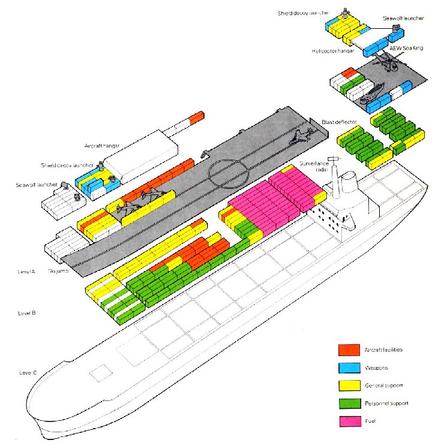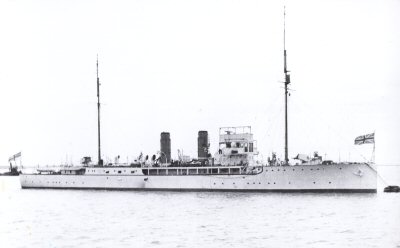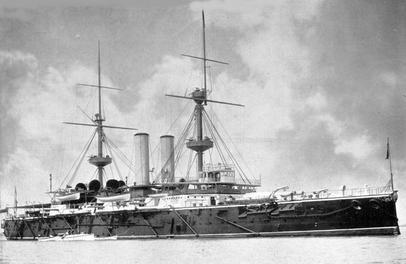March 30, 2009
Accidental Q-Ship
Hah!
A group of Somali Pirates attacked a tanker off the horn of Africa several hours ago. This would be sad but not remarkable as the piracy in the area has been bad for years and exploded in the last few months. However the tanker they attempted to board was the FGS Spessart, a German Navy supply ship.
...and so...
Wasp, meet sledgehammer.
(Hat Tip: Information Dissemination)
A group of Somali Pirates attacked a tanker off the horn of Africa several hours ago. This would be sad but not remarkable as the piracy in the area has been bad for years and exploded in the last few months. However the tanker they attempted to board was the FGS Spessart, a German Navy supply ship.
...and so...
The German sailors returned fire and pursued the skiff while also calling in for support. Several naval ships — including a Greek and a Dutch frigate, a Spanish warship and the USS Boxer — sped to the area while a Spanish marine aircraft and two U.S. Marine Cobra helicopters joined the pursuit.
Five hours later, Greek sailors reached the pirate skiff, boarded it and seized the seven suspects and their weapons, including assault rifles and rocket-propelled grenades, the Greek navy said. The suspects were disarmed and transferred for questioning to the German frigate Rheinland-Pfalz where they remain Monday, pending a decision on whether they will be legally prosecuted, Christensen said.
Wasp, meet sledgehammer.
(Hat Tip: Information Dissemination)
Posted by: The Brickmuppet at
08:22 PM
| Comments (3)
| Add Comment
Post contains 179 words, total size 1 kb.
March 22, 2009
More Ideas for Naval Numbers on a Budget
As has been mentioned here before, the combination of increasing unit costs, aging hulls in need of replacement an increase in the numbers of units needed and the unforced budget debacle facing the treasury has created a procurement conundrum for the US Navy and Coast Guard.
We need ships, lots of ships in a decade or less but given the economy we are likely to have have very little money
Given the high tempo 'medical diplomacy' operations pioneered by the Bush administration as well as the need to respond to disasters such as typhoons, volcanoes, plagues and tsunamis at least some of the vessels we build ought to have some sort of cargo capacity and a larger than average medical facility.
A converted or redesigned merchant design would seem to be the logical choice but if these are to replace the FFGs then it is important to ensure that such a vessel be capable of providing something in the event of a hot war other than terrible ways for bluejackets to die.
The challenges of modern warfare mean that an electronics fit is needed of course so such a ship will bear no relation in cost to whatever merchant ship it is designed from, but it might cost something akin to a modern corvette.
Lets take a standard American containership design, the Philidelphia Class, and assume the aft deck is used for helicopter operation and the aft holds are used as a flex deck for small craft and Littoral combat ship modules. The holds forward of the bridge have ample room for containers that can contain everything from food to hospital or war supplies. I'd use the midships below decks space (where pitching would be minimized )for a big hospital and a secondary helipad (if only to directly service the hospital). This would not have the capability of the Mercy or Comfort but it could conceivably approach that of the LHAs and could do a LOT of good on mercy missions.
It might be less threatening as well. Note that while such a vessel would not be a hospital ship, and would therefore be targetable by law, most people we are likely to lock horns with are unpersuaded by appeals to human decency anyway. Forward of the hospital area, even 2-400 containers would be an impressive ammount of relief supplies in peacetime and still leave room for 16-32 VLS cells for ESSM. The large helideck would give a decent helicopter borne ASW and possibly even minesweeping capability in wartime especially if during a major war something like SCADS or the old ARAPAHO concept were put into place along the lines of this....

We might be able to build a dozen or more of these in commercial yards over the next few years. This would have the added benefit of propping up and stimulating our shipyard capacity during dark economic times in a way that dog parks in California are unlikely to do. Such a program might appeal to the current leadership in ways a more conventional naval procurement would not.
These would probably not able to be procured in the same numbers that 600 ton corvettes might but they could ad a considerable complementary capability to the low end of the hi/lo mix.
At any rate it may bear considering. Any thoughts?
UPDATE: In the comments James Rummel takes the time to comment at length about the idea and makes some lucid points but also indicates that I may have been unclear about as few things.
These are not replacemtnts for our cruisers and destroyers, but a low end complement. If they replace anything they might best replace part of the production run of the LCS vessels....
IF they can be procured more economically and IF they would be a net improvement in capability . These are indeed big "IFs".
There are certainly all sorts of issues with this concept both political and practical. However, I am of the opinion that, if built, these would be warships with peacetime duties similar to a 19th century gunboat but with much greater utility to assist the main force.
Mr Rummel makes another comment that deserves mention.
This is a very real concern.
It is probably one reason the navy doesn't build some smaller carriers to increase survivability through numbers. This was tried in the 70s ant the congress made it plain that it would ONLY buy the smaller carriers and not increase numbers...thereby gutting the navy but giving the impression that congress was providing modern ships.
It does not always work out that way though.
In the 1880's the UKs shipbuilding program was terribly screwed up, with problems that included cost overruns, excessively long build times, ships massively over budget as well as overdue, quality control issues, problems integrating new technologies and simple corruption (sound familiar?). The response was to, for a time, order only second line vessels such as gunboats and auxiliaries as well as a few experimental technology test beds such as experimental high speed craft (the torpedo boats).
These were often ordered outside the usual defense procurement clique.
In the meantime the procurement system was overhauled, investment was made in physical plant improvements at the shipyards and the procurement system was reformed, Concurrently, a determination of what sort of vessels were needed was made. Then rational, attainable requirements for the various types of vessels were drawn up that matched the then current technologies, the national strategy of the time as well as the gamut of potential scenarios.
After several years of building gunboats and finishing the dubious vessels that were already ordered, the Royal Navy began building ships under the Naval Defence Act. William Whites design team produced the finest ships that had been built up to that time and for nearly two decades, every subsequent class was an improvement on their design predecessor in some way.
From that point until WW1 the British Royal Navy built a balanced fleet and produced some of the best, most economical; and cost effective ships of their day.
So while the pitfall Mr Rummel points out is very real, it can in fact be avoided if care is taken and the legislature acts in good faith...another very big "IF".
We need ships, lots of ships in a decade or less but given the economy we are likely to have have very little money
Given the high tempo 'medical diplomacy' operations pioneered by the Bush administration as well as the need to respond to disasters such as typhoons, volcanoes, plagues and tsunamis at least some of the vessels we build ought to have some sort of cargo capacity and a larger than average medical facility.
A converted or redesigned merchant design would seem to be the logical choice but if these are to replace the FFGs then it is important to ensure that such a vessel be capable of providing something in the event of a hot war other than terrible ways for bluejackets to die.
This is not unheard of. The Flower class sloops of world war one were built to commercial standards, had a modest cargo capacity and were intended to serve as minesweepers, troopers, escorts, picket vessels, gunboats and light replenishment ships. They were not frontline ships but they were not helpless either and provided sterling service as convoy escorts and on gunboat duties between the wars. 

The challenges of modern warfare mean that an electronics fit is needed of course so such a ship will bear no relation in cost to whatever merchant ship it is designed from, but it might cost something akin to a modern corvette.
Lets take a standard American containership design, the Philidelphia Class, and assume the aft deck is used for helicopter operation and the aft holds are used as a flex deck for small craft and Littoral combat ship modules. The holds forward of the bridge have ample room for containers that can contain everything from food to hospital or war supplies. I'd use the midships below decks space (where pitching would be minimized )for a big hospital and a secondary helipad (if only to directly service the hospital). This would not have the capability of the Mercy or Comfort but it could conceivably approach that of the LHAs and could do a LOT of good on mercy missions.
It might be less threatening as well. Note that while such a vessel would not be a hospital ship, and would therefore be targetable by law, most people we are likely to lock horns with are unpersuaded by appeals to human decency anyway. Forward of the hospital area, even 2-400 containers would be an impressive ammount of relief supplies in peacetime and still leave room for 16-32 VLS cells for ESSM. The large helideck would give a decent helicopter borne ASW and possibly even minesweeping capability in wartime especially if during a major war something like SCADS or the old ARAPAHO concept were put into place along the lines of this....

These would probably not able to be procured in the same numbers that 600 ton corvettes might but they could ad a considerable complementary capability to the low end of the hi/lo mix.
At any rate it may bear considering. Any thoughts?
UPDATE: In the comments James Rummel takes the time to comment at length about the idea and makes some lucid points but also indicates that I may have been unclear about as few things.
These are not replacemtnts for our cruisers and destroyers, but a low end complement. If they replace anything they might best replace part of the production run of the LCS vessels....
IF they can be procured more economically and IF they would be a net improvement in capability . These are indeed big "IFs".
There are certainly all sorts of issues with this concept both political and practical. However, I am of the opinion that, if built, these would be warships with peacetime duties similar to a 19th century gunboat but with much greater utility to assist the main force.
Mr Rummel makes another comment that deserves mention.
You suggest that this is only a temporary change until economic conditions improve. But anyone interested in military procurement will tell you in a heartbeat that it would be almost impossible to get Congress to pony up for actual, very expensive warships after a decade of building cheaper cargo ships. Once the change is made, there is no going back.
This is a very real concern.
It is probably one reason the navy doesn't build some smaller carriers to increase survivability through numbers. This was tried in the 70s ant the congress made it plain that it would ONLY buy the smaller carriers and not increase numbers...thereby gutting the navy but giving the impression that congress was providing modern ships.
It does not always work out that way though.
In the 1880's the UKs shipbuilding program was terribly screwed up, with problems that included cost overruns, excessively long build times, ships massively over budget as well as overdue, quality control issues, problems integrating new technologies and simple corruption (sound familiar?). The response was to, for a time, order only second line vessels such as gunboats and auxiliaries as well as a few experimental technology test beds such as experimental high speed craft (the torpedo boats).
These were often ordered outside the usual defense procurement clique.
In the meantime the procurement system was overhauled, investment was made in physical plant improvements at the shipyards and the procurement system was reformed, Concurrently, a determination of what sort of vessels were needed was made. Then rational, attainable requirements for the various types of vessels were drawn up that matched the then current technologies, the national strategy of the time as well as the gamut of potential scenarios.
After several years of building gunboats and finishing the dubious vessels that were already ordered, the Royal Navy began building ships under the Naval Defence Act. William Whites design team produced the finest ships that had been built up to that time and for nearly two decades, every subsequent class was an improvement on their design predecessor in some way.
From that point until WW1 the British Royal Navy built a balanced fleet and produced some of the best, most economical; and cost effective ships of their day.
So while the pitfall Mr Rummel points out is very real, it can in fact be avoided if care is taken and the legislature acts in good faith...another very big "IF".
Posted by: The Brickmuppet at
12:00 AM
| Comments (10)
| Add Comment
Post contains 1172 words, total size 8 kb.
<< Page 1 of 1 >>
49kb generated in CPU 0.018, elapsed 0.0848 seconds.
68 queries taking 0.0712 seconds, 223 records returned.
Powered by Minx 1.1.6c-pink.
68 queries taking 0.0712 seconds, 223 records returned.
Powered by Minx 1.1.6c-pink.










